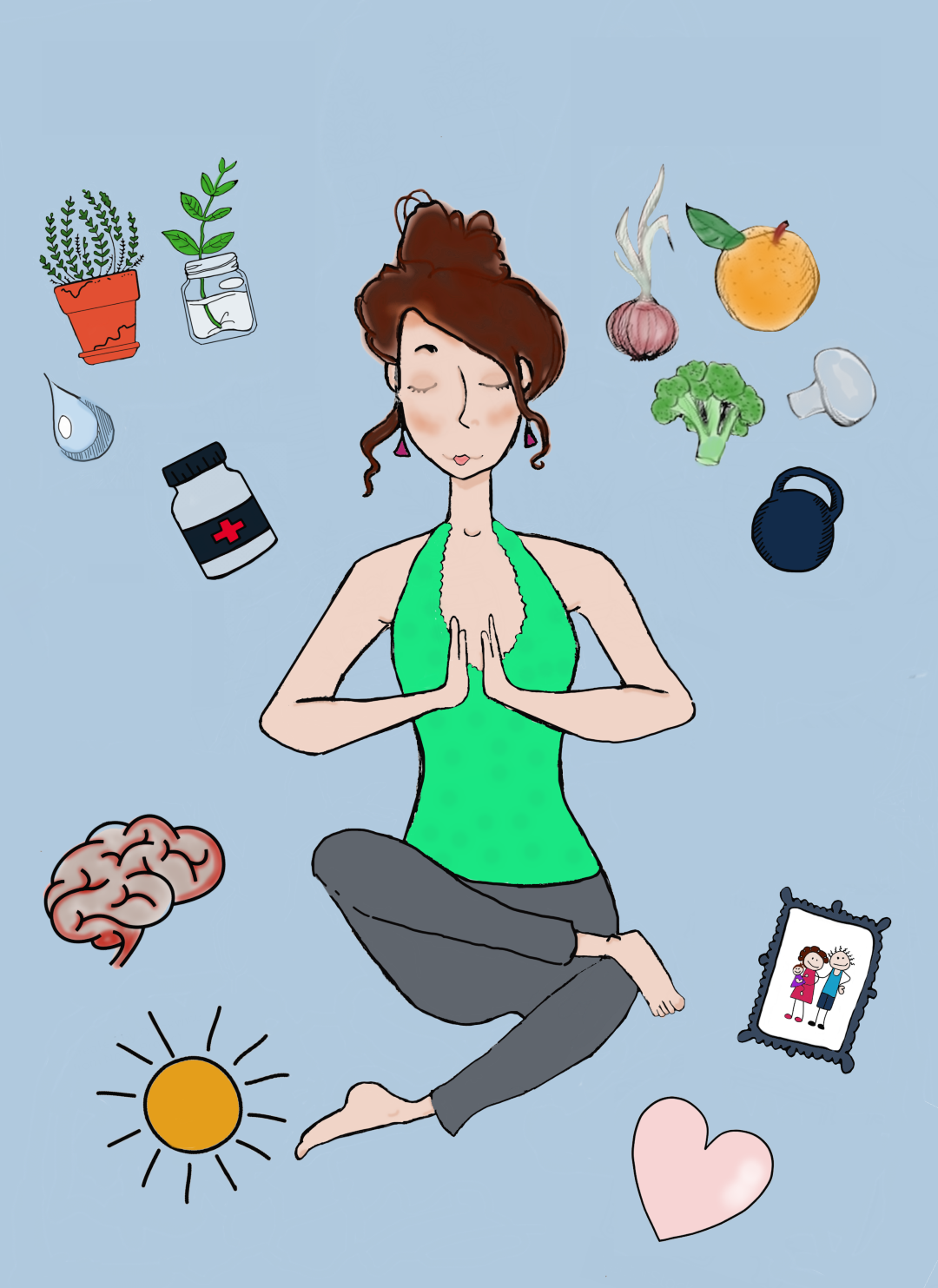
Interviewing certified nutritionists Eve Lansink and Kaitlynn Hoffman
By Alexis Zygan, Staff Writer
The education system fails to guide students towards healthy lifestyle choices. Serving sizes on nutrition labels are enigmatic. And although health and wellness are part of the curriculum, there are gaps in the lesson plan. By the time students enter university and are buying groceries, most of what was taught about healthy eating is forgotten. As pupils struggle with balancing classes, assignments, and household chores they barely have any time left in the day for cooking—especially cooking unprocessed whole foods that include all the nutrients to stimulate brain health. As a result, by their second semester students are dehydrated, fatigued, and gravitating towards unhealthy ways of coping with the pressures of early adulthood. The average college student pulls all-nighters to study, binges on alcohol on the weekends, and eats fast food because it’s convenient and cheap. Meanwhile, all the required readings, essay deadlines, and tests interfere with their ability to reduce stress.
Kaitlynn Hoffman, a registered holistic nutritionist and graduate of the Canadian School of Natural Nutrition, emphasizes the importance of mindfulness. “If the seeds of mindfulness practice are planted from a younger age, navigating stress and learning what our body needs becomes much easier.” Hoffman’s practice of nutrition focuses on making healthy choices not only for our physical health but for our mental health as well. For another perspective, I reached out to nutrition specialist Eve Lansink who received her certification from Precision Nutrition. Lansink specializes in providing personalized nutritionist advice and fitness coaching. She is passionate about helping sex workers who have notoriously busy schedules. Having worked as a stripper herself, she aims to “elevate their physical and spiritual health through love and support.”
The habits we develop early in life stay with us—ask anyone who started smoking as a teenager. Unfortunately, changing ingrained patterns in our 30s is far more challenging. On the flip side, young adults who adopt healthy habits are set for success. Hoffman reminds us that “if you prioritize taking care of yourself, starting with your physical health, everything else starts to snowball.” But how are we supposed to know what taking care of ourselves looks like if we are never in school? We know it’s vital to get outside and move our bodies, but beyond that, a lot is overlooked or taken for granted. “I just don’t think the practice of nutrition is even acknowledged as something that needs to be taught. It’s just assumed that it’s inherent, which it’s definitely not,” says Lansink. Instead, nutrition lessons are merged with other subjects like physical education.
“I just don’t think the practice of nutrition is even acknowledged as something that needs to be taught. It’s just assumed that it’s inherent, which it’s definitely not.”
– Eve Lansink, Nutrition Specialist
When I attended high school, I analyzed the Canada Food Guide and created a meal plan. The 2020 updated Canada Food Guide offers tips for healthy habits, such as prioritizing drinking water over any other beverage and eating plenty of fruits and vegetables. However, it doesn’t specify which nutrients make for balanced meal plans. According to Lansink’s expertise in nutrition, “many people are not getting enough micronutrients, specifically fibre.” A study uncovered that 95 percent of people don’t meet the recommended daily fibre intake. Dietary fibre is vital for bowel health and it prevents heart disease, stroke, and obesity. Gut health is critical as that is where the majority of our serotonin is stored. In addition, an unhealthy gut contributes to insomnia and chronic fatigue; consider this alongside the fact that many college students can’t start their day without coffee or an energy drink. Gut health is imperative for optimal quality of life. Lansink suggests adding lentils or kidney beans to a meal for adequate dietary fiber. And Kaitlynn’s advice for enjoying morning coffee is to stay hydrated with lemon water (which supports digestion) and choose a quality organic bean.
During my conversation with Lansink, she brought up the importance of getting enough macro and micronutrients daily. Macronutrients are carbohydrates, proteins, and fats. We need a lot of these to give us energy! The majority of our macronutrient intake—40 percent in total—should be from carbs, such as bread, grains, pasta, vegetables, and fruits. There is a misconception that carbs are bad. In reality, they are essential for our health and should be the largest food group in our diet. Micronutrients, on the other hand, are vitamins and minerals. If you aren’t getting enough of a specific vitamin or mineral, you can add supplements to your routine. To find out if you’re getting enough, get a blood test or speak to a nutritionist.
“Many people are restricting calories so they’re not getting enough of their macronutrients,” explains Lansink. People develop an unhealthy relationship with their food habits because of the lack of education. The rise of social media use, specifically Instagram, isn’t helping. Users see airbrushed bodies on the app with thin waists and thick hips, advertising that [viewers] can achieve the same body through laxative teas or low-calorie diets. It’s harmful and fails to acknowledge that health exists at every size. You don’t have to go to the gym seven days a week, drink a spinach smoothie every morning, and avoid carbs to be the healthiest version of yourself. Lansink says that “regardless of someone’s physical ability, I feel like nutrition is vital. It’s so important for people to practice mindful nutrition.” That is paying attention to the food we eat, eating with purpose, and without judgement. Focusing more so on awareness through the senses rather than counting and restricting calories. Hoffman affirms this in saying, “our bodies have this innate wisdom.”
“Take time to burn off the energy that’s related to stress from a holistic perspective. So that might be moderate to high-intensity exercise. Even socializing and taking time to laugh can be really, really helpful.”
– Kaitlynn Hoffman, Holistic Nutritionist
Another barrier to healthy eating mentioned earlier is the cost of healthy food. According to Harvard Public Health, eating healthy costs $1.50 more a day, totaling $2000 per year. For the 40 percent of Canadian post-secondary students who depend on student loans for their living expenses, tacking another $2000 onto their yearly budget is unfeasible. As college students, it can be hard to know which foods create cheap and easy meals. Lansink shared a tip that frozen produce is equally as nutritious as fresh produce. So, if you’re low on cash but still want to take care of your health, purchase a bag of spinach from the freezer section and add it to your next dinner. Hoffman also suggests meal boxes such as HelloFresh, as you can oftentimes find discount codes where you don’t have to pay full price. Hoffman says, “it was really awesome just to know that I’m giving myself something that’s good quality and it’s fairly healthy.”
It is no surprise that college students are more stressed than ever before. Unsure of how the economy will impact their job prospects after graduation. Accumulating all that debt and hoping that it’s all worthwhile. Minimizing stress is ideal for overall physical health. However, that may be unfeasible for some college students. In the meantime, start by becoming aware of your boundaries and limits. Sometimes we take on more than we can handle, which can be detrimental to our mental health. Hoffman says, “taking time to burn off the energy that’s related to stress from a holistic perspective. So that might be moderate to high-intensity exercise. Even socializing and taking time to laugh can be really, really helpful.” Chronic stress can lead to burnout, so making time for exercise and laughter in between studying is beneficial for a better semester. A person’s mental and physical health is impacted by what they eat and what company they keep. Friendship is vital for combating loneliness, but toxic friends who aren’t supportive can be worse than staying alone. Hoffman reminds readers to “surround yourself with people who are in the same mindset. Rather than feeling like you’re just trying to advocate for yourself and don’t feel supported.”
Healthy living may seem unachievable for many college students who are strapped for cash. Thankfully, beans, lentils, and brown rice are pantry staples that are cheap and versatile. However, finding ways to eat healthy while living on a college student budget requires a bit of innovation and choosing a can of beans over bacon—which may be difficult at the moment—will pay off long-term. For example, swap out ramen for a quick coconut lentil curry. Then, freeze the meal and reheat it to fuel you throughout the week. Or add spinach to the ramen for a more filling and nutrient-dense meal. Hoffman reminds us that staying healthy doesn’t have to be complicated or expensive. In fact, she says, “it’s as simple as getting enough sleep, eating foods that feel good in your own body, and taking 20 minutes a day to do some movement.”
For readers who are interested in learning more about intuitive eating and nutrition, you can find Kaitlyn Hoffman on Instagram @thenomnivorenutrition. Readers interested in achieving their health and fitness goals should reach out to Eve Lansink on Instagram @trainstripperstrong.


